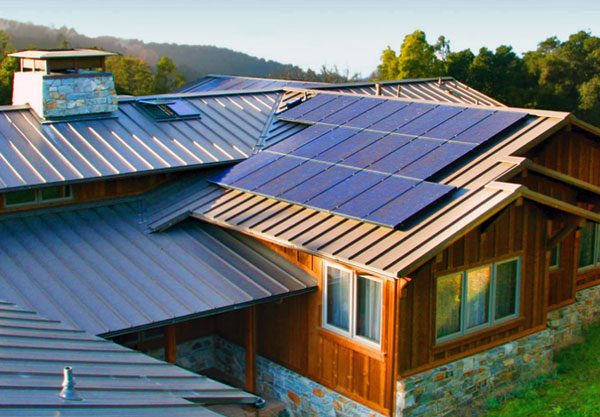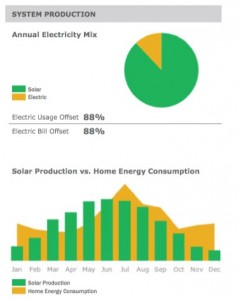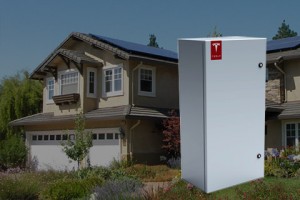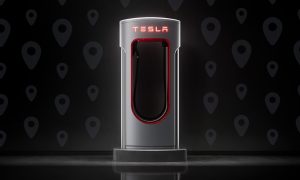Solar Gains
Even with crazy electricity prices in Massachusetts, driving a Tesla is 38% of the cost of driving a gas-powered vehicle. But unlike oil and gasoline, you can generate your own power through renewable solar energy.
After ordering my Tesla Model S I started looking into solar panels for my home. I only looked at a single provider, SolarCity, for a couple of reasons. First, SolarCity is dominating the solar residential market with over 19% in market share. Second, it’s associated with Elon Musk and without him I wouldn’t even have the Tesla. I didn’t know much about SolarCity’s business model or approach – I simply filled out a contact form online and took it from there.

SolarCity Consultation & On-Site Evaluation
The process starts with a qualification call with a Solar City sales person to. They ask whether you own your home, what your electric usage is like, if you have a condo association and a few other random questions. They pull up your home address through Google maps and verify whether your location qualifies for their solar program. Here in Massachusetts only 1 in 7 (14%) of homes qualify for solar. Disqualification happens for reasons such as not having enough space on the roof for the panels, too much tree coverage or wrong facing roof lines.
The next step is to arrange an on-site visit of your property which for me lasted just over 2 hours. The SolarCity representative asked about our preference in solar panel placement (i.e. not on the front of the house for aesthetic reasons) and with that they were able to suggest areas of the roof where the solar panels would be most optimal. They pulled up a Google maps image of the home and produced a rendering of the home with the proposed solar cell placements. A custom report was generated that outlines the solar panel dimensions, numbers of solar cells to be installed, estimated production time and distribution of sunlight onto the solar panels while factoring in the direction of sunlight. It was quite an impressive report.

SolarCity analyzed my actual electricity usage history and was able to calculate the annual kWh consumed along with the cost for that energy. They use historical weather data in your city/state and look for weather patterns over the last several years, in order to estimate how much real coverage you will get from the solar panels.
 Based on SolarCity’s evaluation, their proposed solution would cover 88% of my electricity needs and cut my average monthly bill of $377 to $45. When the green line is above the yellow, you’re essentially producing more solar derived electricity than you need, and as a result you have to accumulate credits within your account. This big drop in monthly electricity cost is the “bait” portion of the sales pitch. Lots of focus is placed on the amount of energy that can be recouped, but this doesn’t all come for free.
Based on SolarCity’s evaluation, their proposed solution would cover 88% of my electricity needs and cut my average monthly bill of $377 to $45. When the green line is above the yellow, you’re essentially producing more solar derived electricity than you need, and as a result you have to accumulate credits within your account. This big drop in monthly electricity cost is the “bait” portion of the sales pitch. Lots of focus is placed on the amount of energy that can be recouped, but this doesn’t all come for free.
The SolarCity system designed for our house costs about $144k in total. With green credits in place (going to SolarCity), the cost ends up to be approximately $68k.
They don’t give you $68k of hardware for free — SolarCity’s business model is pretty simple:
“Take dollars going to power companies and divert most of it to SolarCity while giving the homeowner enough incentive to do so.”
SolarCity provides you with free hardware and then charges you a rate based on the amount of solar power used. The amount of solar energy placed back into the grid offsets your electricity usage and bill, but can never exceed (at least in Massachusetts) the bill to the point where you are paid for generating energy. In other words, you’ll want to design a system that provides as close to 100% coverage of your electric bill as possible without going under or over. Going under means you’re paying the higher price per kWh through your standard electricity provider while going over means that you’re paying for excess generation of power while not being able to use it.
Reducing Electricity Bills with Solar Energy
SolarCity does not want to sell you a system. They want to enter into a long term (20 year) agreement with you that requires you to buy power from the solar panels they place into your home. They provide a few options to do this:
- Pay a medium rate for the generated power, but with no increase year over year.
- Pay a lower rate for the generated power, but with a 2.9% increase year over year.
- Pay nothing for generated power, but with a big up front pre-payment at the lowest rate.
All their rates start lower than your current electricity rate. Lets look at how a 2,500 kWh / month usage breaks down:
- With Electricity provider: 2,500 kWh x 16.7¢/kWh = $417.50
- With SolarCity: 2,500 kWh x 88% x 14.8¢/kWh + 2,500 kWh x 12% x 16.7¢/kWh = $373.60
The 88% offset number can vary when you get to the actual implementation, but the rep said the estimates are usually conservative.
Choosing option #1 would give an immediate 10.5% savings which is far from the 88% savings they claim to give. The utility company was receiving $417.50 for my energy usage, but with the proposed SolarCity system, the utility company’s cut would diminish to $48 while SolarCity would receive $325.60. SolarCity and the homeowner wins; the power company loses revenue, but gets relief on the grid and even more relief during the hotter months when the grid is the most strained.
 Electric companies are hiking rates year over year. The rep quoted an average annual rate hike of 4.8% in Massachusetts, but taking a deeper look at a historical rate chart for my area, I saw an annual increase of 5.7% since 2008. Assuming this same growth pattern over the next 10 years, SolarCity’s solar panel system should provide a 40% savings in energy costs in the later years.
Electric companies are hiking rates year over year. The rep quoted an average annual rate hike of 4.8% in Massachusetts, but taking a deeper look at a historical rate chart for my area, I saw an annual increase of 5.7% since 2008. Assuming this same growth pattern over the next 10 years, SolarCity’s solar panel system should provide a 40% savings in energy costs in the later years.
The choice in SolarCity plans really depends on how long you expect to stay in your house. If you’re only staying for a few more years, go with the one with the lowest rate and no upfront payment. If this is the last house you’ll own and you can afford to, then pre-pay for the system. Otherwise (like me), go in the middle. The break-even point between plan 1 and plan 2 is 8 years.
SolarCity’s Solar Panel System in the Long Run
My system has an estimated production of 23,830 kWh per year with a fixed cost to me at 14.8¢/kWh. Total payout to SolarCity for use of the solar energy will be $70,536.80 over 20 years. Since the cost of the solar panel system costs them around $68K after credits, you’re essentially paying for the whole system over the 20 years, but at the end you don’t own it.
There are a few options that can be had after the 20 year mark:
- Renew for some additional 5 year periods with different numbers/rates.
- Upgrade system to something newer with different numbers/rates.
- Have them take it all away and put the house back to pre-solar state (this is totally free to do).
There are a few other things to note:
- They guarantee your entire roof from leaks for the first year after install.
- The entire system is insured, maintained, owned by them — anything breaks and they fix it for free (labor + parts).
- They’re incentivized to make it work, and work well, because they get paid on energy production and usage. That’s an expensive set of gear (almost $150K in our case) and something you don’t have to worry about.
- The agreements etc are fully transferable to a new home buyer.
- They have applications to monitor power generation through your mobile and desktop devices.
How does SolarCity make money? I don’t know their whole business model but there are a few things you can infer:
- I don’t buy the quoted costs of the gear and it seems others, like Forbes, don’t either. Perhaps the retail price for the solar set up would be $144K, but as the largest solar installer in the US, SolarCity undoubtedly is getting some huge price breaks.
- The power companies are mandated to produce a certain amount of green energy and when they can’t there are fines to be had. Similar to how Tesla sells their earned green credits back to the power companies. I’ve seen estimates that for every Tesla sold, 5 green credits are created worth a total of $35,000 that other auto companies buy from Tesla. So not only do they generate $100k in revenue from the car, they receive an additional $35k through the green credits.
 From the outside it’s really hard to tell what SolarCity’s long term business strategy will be. To me, it’s simple. I have some high value equipment on my roof offsetting real electric rates and a contract for a fixed price over the long term with no real downside. I’ll let them worry about their business and I’ll just worry about my house.
From the outside it’s really hard to tell what SolarCity’s long term business strategy will be. To me, it’s simple. I have some high value equipment on my roof offsetting real electric rates and a contract for a fixed price over the long term with no real downside. I’ll let them worry about their business and I’ll just worry about my house.
I started down this path because of the Tesla. I’ve averaged 90 miles a day over the last 6 months in my ICE car. Using Tesla’s calculator that’s equivalent to 29.7 kWh/day or 10,841 kWh/year of energy that I’ll be using (about $1,800 worth if I get it straight from the power company). Still a big savings over $6,000/year in gas and even more when combined with solar. The $1,800 goes to about $1,600 this year ($200 savings), and 10 years from now I’m saving 50% over what I’d normally be paying to my utility company.
Going solar for me was pretty much a no-brainer. Gas prices are going up and so are electricity prices. Solar provides cleaner power at less cost with no upfront fees and no upkeep that I’m responsible for, and it will help offset the additional cost of electricity from my new Tesla and make it even more cost effective over time.
RELATED: SolarCity Struggles: My Three Part Series on the Journey Taken with SolarCity











